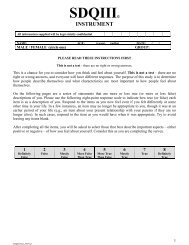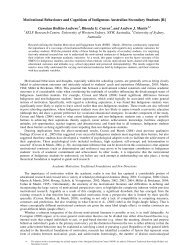Perceived Self-Efficacy in Health Behaviour Change The Construct of
Perceived Self-Efficacy in Health Behaviour Change The Construct of
Perceived Self-Efficacy in Health Behaviour Change The Construct of
Create successful ePaper yourself
Turn your PDF publications into a flip-book with our unique Google optimized e-Paper software.
<strong>The</strong> results also shed light on the work<strong>in</strong>g mechanism <strong>of</strong> these <strong>in</strong>terventions: self-efficacy<br />
change mediated the effects <strong>of</strong> the self-efficacy <strong>in</strong>tervention on change <strong>in</strong> fruit and vegetable<br />
consumption, whereas changes <strong>in</strong> both self-efficacy and plann<strong>in</strong>g mediated the effects <strong>of</strong> the<br />
comb<strong>in</strong>ed <strong>in</strong>tervention (address<strong>in</strong>g self-efficacy and plann<strong>in</strong>g). <strong>The</strong> results support Bandura’s<br />
(1997) suggestions, show<strong>in</strong>g that an enhancement <strong>of</strong> self-efficacy by means <strong>of</strong> verbal<br />
persuasion and positive emotion may result <strong>in</strong> behaviour change. <strong>The</strong> results are also <strong>in</strong> l<strong>in</strong>e<br />
with studies show<strong>in</strong>g that plann<strong>in</strong>g <strong>in</strong>terventions may work because they encourage a person<br />
to engage <strong>in</strong> more frequent use <strong>of</strong> strategy plann<strong>in</strong>g.<br />
Study II: Moderated Mediation <strong>of</strong> Dietary <strong>Behaviour</strong> <strong>Change</strong> <strong>in</strong> South Korean Women<br />
Previous analyses (Lippke et al., <strong>in</strong> press) have confirmed the partial mediation <strong>of</strong> the<br />
<strong>in</strong>tention-behaviour relationship by plann<strong>in</strong>g, and identified levels <strong>of</strong> perceived self-efficacy<br />
as moderators <strong>of</strong> this mediation. As this study predicted dietary behaviours, and not<br />
behavioural change, the analyses needed to be replicated. This was done <strong>in</strong> a longitud<strong>in</strong>al<br />
sample <strong>of</strong> 358 women that responded to two questionnaires six months apart <strong>in</strong> a study <strong>in</strong><br />
South Korea (Gutierrez et al., 2009; Renner et al., 2008).<br />
Moderated mediation analyses <strong>in</strong>dicated a moderation effect (see Figure 2). <strong>The</strong> path<br />
diagram consists <strong>of</strong> a mediator model (to expla<strong>in</strong> plann<strong>in</strong>g) and a dependent variable model<br />
(to expla<strong>in</strong> behaviour). First, <strong>in</strong>tentions emerged as the best predictor <strong>of</strong> cop<strong>in</strong>g plann<strong>in</strong>g,<br />
followed by the <strong>in</strong>teraction between <strong>in</strong>tentions and self-efficacy, whereas the ma<strong>in</strong> effect <strong>of</strong><br />
self-efficacy was rather negligible, overall account<strong>in</strong>g for 18% <strong>of</strong> the plann<strong>in</strong>g variance.<br />
Second, basel<strong>in</strong>e behaviour was the best predictor <strong>of</strong> Time 2 low-fat diet, followed by<br />
plann<strong>in</strong>g, whereas <strong>in</strong>tentions did not make a contribution, overall account<strong>in</strong>g for 51% <strong>of</strong> the<br />
behaviour variance. Thus, there is a full mediation <strong>of</strong> the <strong>in</strong>tention-behaviour relation via<br />
plann<strong>in</strong>g, moderated by self-efficacy.<br />
Figure 2. Moderated mediation model for South Korean women<br />
This analysis corroborated the hypothesized mediation effect, conditional upon the value <strong>of</strong><br />
self-efficacy, underscor<strong>in</strong>g the f<strong>in</strong>d<strong>in</strong>g that plann<strong>in</strong>g translated <strong>in</strong>tentions <strong>in</strong>to behaviour, but<br />
not with<strong>in</strong> the subgroup <strong>of</strong> <strong>in</strong>dividuals who had very low levels <strong>of</strong> self-efficacy.





